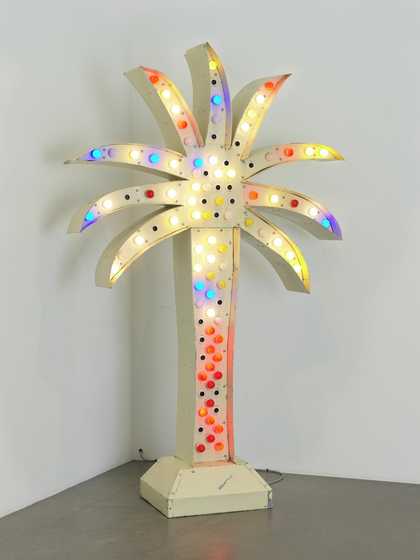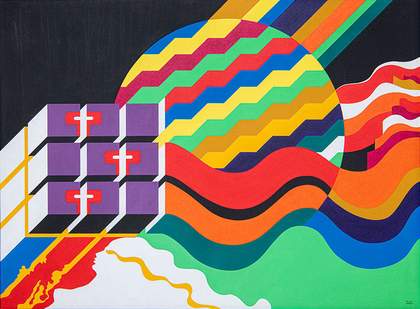The way the cities were built here was an experimental project for other cities that were going to be built in the future, mainly in Latin America.
So it's a very interesting period of time where questions are answered to serve the French and Spanish domination.
I'm very much interested in the most, almost invisible forms of domination that we forget about in history and then what is the incredible inventivity of how to get around them.
-No, no
-There’s no way I could ever do something like that
-And it's a matter of calculating the distance in the exact same way every time
-Inside one, two... pull
-Okay, I'm ready
-In the middle, pull it like this
-Yes
-And now twice from underneath
-Raise the thread for me
-In front you do a stitch, then you go underneath, under the loop here
-This one?
-Whichever
-I can't see anything! I can't see
The Mothership is a place where you can have space and time to restore yourself: to work and study. It's a residence, but also a retreat and we have a dye garden with a big dye house in the centre.
It's a family home and it's on the Strait of Gibraltar in the city of Tangier.
And it's a place we imagine as a lab of experimentation and sustainability.
We have gardeners, painters writers, poets and dyers or artists like myself that are interested in this question.
Indigo is the only dye that's invisible and insoluble and that's why there’s a lot of different steps to the other dye stuff.
-No, you stay underwater... it's like a crocodile trying to get out... Let me take it out to oxidise
We have the drying racks, full of flowers before colour extraction.
This is the dye stuff. Sometimes it's leaves, sometimes it's bark... and here they’re flowers and the leaves.
This is coreopsis. The colour you can get is... this is on silk velvet... is this.
-Good boy Patch... Give it to me... Drop it... Here
What matters here is that there's a lot of piles and that's part of my work. Moving things around, making associations.
There's an entropy of the piles, they’re alive and that's how I start thinking of a project.
There's the formal approach to the way they studied the country, the way they had criterias of what the population needed through the colonial framework.
And then from there I will chew it and spit it out again.
So there's this relationship to the archival material that is very carnivorous... I have like a huge appetite for it and I'm going to digest it, twist it, add to it, use it, work with it as raw material but also have a discursive approach to what's missing...
What are the misunderstandings?
What is the hidden violence of deciding without the local population?
Dye with Black-eyed Susan: gather leaves and/or flower heads. They give different colours so keep them separate. Any time in summer and early fall, you may dry or freeze them for later use.
It takes prolonged boiling and soaking to extract the pigment from Black-eyed Susan. Cover with water, heat to full boil not just a simmer and boil for 1 to 2 hours then let the pot sit at room temperature for an additional day or two before straining off the dye bath.
-This used to be a public beach here and now it's a coastal road with a very small beach
15 years ago when we transformed and saved the Cinema Rif, the project was to have arthouse cinema come back to the city because this was for a very long time one of the capitals of cinema in the country with many theatres and that's what we wanted to revive, build a community around film, workshops, classes, educational programmes for kids.
We have a small screening room with a 50 seat theatre and we have a 300 seat theatre. We also have the archive room, the offices, the library with all the books that filmmakers gave us and a café that overlooks the historic square of Tangier: Independence, the Grand Socco, that is the border between the old and the new city.
-In the evening my father sits us down all around the big table in the dining room. He opens a book, The Spirit of Laws by Montesquieu and makes us take dictation. Everyone has to do it. The children who can barely write and those who are finishing school.. I have to make an effort to form the letters others are trying not to make
In the archive rooms there's big posters but there's also small leaflets that were the publicity for the cinema here.
1955... That's a year before our independence.
'The specialist in women'
There's also a specific Tangier collection, Morocco and Tangier collection of film noir.
One of the tropes you find a lot around this area is the threat... Tangier is a threatening place.
Because we didn't have the material for distribution, we decided to commission posters to local artists let me show you this beautiful one. That's one of my favourites. This is Fassbinder. This is The Bitter Tears of Petra von Kant.
And this is the original poster from Tangier with Maria Montez.
All the archives that I had collected are still a permanent resource to make work from.
It's about transmission.
It’s about recollection, memory, rethinking what was the accumulation of knowledge, the way it was made, what made sense, what doesn't make sense anymore.
I'll pull a thread, I'll find a form, I'll make something and I'm hoping that it makes sense in the future.
The Mothership is a garden on the Strait of Gibraltar, and yet much more than that.
It's a residence, and a retreat, a dye garden, an experimental lab and a family home. It's a place where artists, gardeners, writers and poets can find the time and space to restore themselves, to work and study.
In this film, artist Yto Barrada invites us into the Mothership as well as to the Cinémathèque de Tanger, two important centres of art and 'inventivity' in the city of Tangier, Morocco.
Research supported by Hyundai Tate Research Centre: Transnational in partnership with Hyundai Motor



